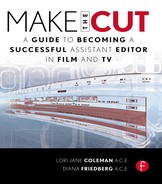Chapter 2 Before Your First Day on the Job
2.9 MX: Needle Drops and Score
3.1 Setting Up the Project Window
4.4 Continue to Digitize or Begin to Organize
4.9 When Dailies Are Completed
Chapter 5 Edit and Distribute the Cut
5.6 Scene Timings and Total Measurements
5.11 Privacy in the Editing Room
6.1 Create a Locked Sequence Bin
6.2 Remove Add Edits and Check for Jump Cuts
6.3 Format the Locked Sequence
6.5 Create the Locked Continuity and MX Sheet
6.9 Create the Chase Cassette (DVD)
6.10 Create the PIX and Audio Edit Decision Lists (EDLs) and the OMFs
6.11 Prepare for SFX and MX Spotting
6.12 Duplicate the Script and Sound Reports
Chapter 7 Assisting Protocols for Documentaries
Chapter 8 Assisting Protocols for Reality Shows
8.3 Work Space Synchronization
8.4 Offline and Online Management
8.5 Digitizing and Organizing Dailies
…Step 3: Check for Timecode Drift
…Step 4: Synching Each Camera to the Base Camera on V1
…Step 5: Set Auxiliary TC for the Base Camera
…Step 6: Adjust the Aux TC for the Rest of the Cameras
…Step 7: Add Edits at Every Place on the Sequence Where a Clip Starts or Stops
…Step 8: Creating the Subclips from the Sequence
…Step 9: Create the Multigroup by Auxiliary TC
8.8 Things to Check Before Outputting a QT or DVD
8.15 Assisting on FCP in Reality Television
8.16 Importing and Organizing the Project
Chapter 9 First Day Observations in the Editing Room
9.1 A Day on Episodic Television
…Laura Sempel (American Intern 2010)
9.2 Different Venue in Episodic Television
…Andreas Arnheiter (International Intern 2010)
…Paul Penczner (American Intern 2010)
…Nompi Vilakaze (International Intern 2010)
Chapter 10 The Unwritten Rules of the Editing Room
10.1 Be on Time (15 Minutes Early)
10.6 Informative Messages and Post-it Notes
11.6 Leave Your Problems at Home
11.11 Noise and Personal Hygiene
11.12 Creating Ambience Levels
Chapter 12 Navigating the Room
12.2 Know When to Leave the Room
12.6 Giving Your Opinion on a Scene
Chapter 13 Approaching Your Career
13.2 Develop a Relationship with the Post Staff
13.6 Gracefully Leaving Your Nonunion Job
13.8 Choose Your Genre: From Features to Television
Chapter 14 Plan Ahead and Move Up
14.3 Perform at Your Highest Level
14.7 Gracefully Leaving Your Union Job
Chapter 15 On the Brink of Editing
